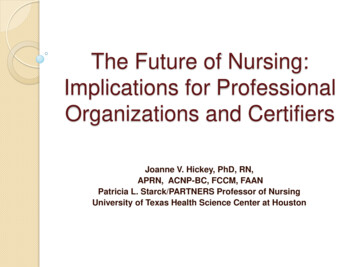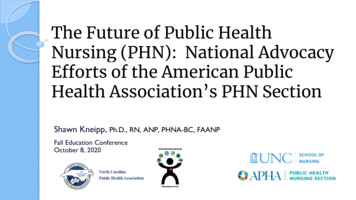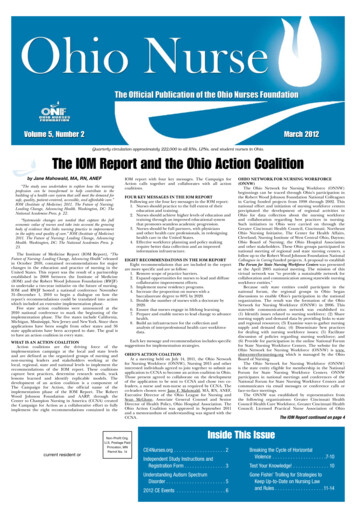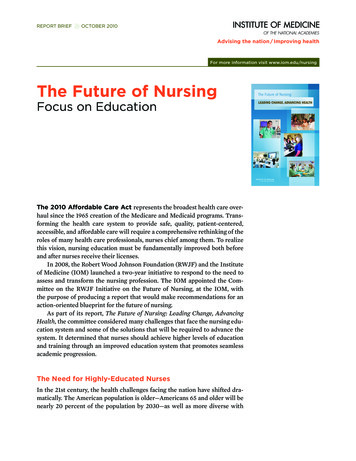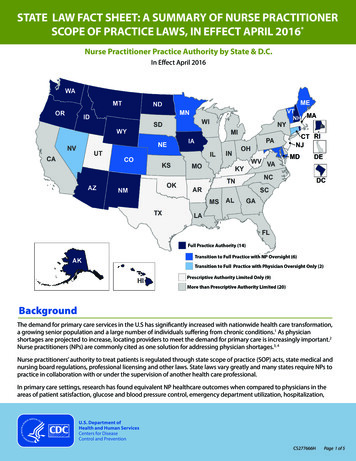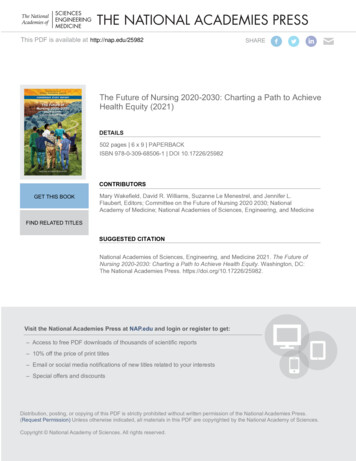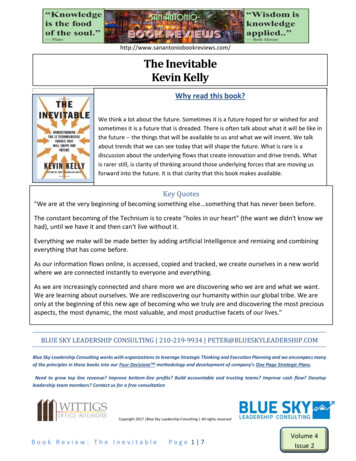
Transcription
3/29/2011The IOM’s Future of Nursing Reportand Implications for the Oregon CNSMichael R. Bleich, PhD, RN, FAANDean and Dr. Carol A. Lindeman Distinguished Professor of NursingVice Provost for Interprofessional Education and DevelopmentOregon Health & Science UniversityMarch 1, 2011The ReportMessages and recommendationsare from The Future of Nursing:Leading Change, AdvancingHealth report, published by theInstitute of Medicine of theNational AcademiesVisit http://www.iom.edu/nursing to view the report1
3/29/2011Committee on the RWJF initiative onthe Future of Nursing, at the IOM18 members (5 intergenerational nurses) with expertise in: Public health Nursing Federal & stateadministration Hospital & health planadministration Business administration Health information & technology Health services research Health policy Workforce research & policy Economics Health care consumerperspectiveStudy Process 5 committee meetings 3 public workshops 3 public forums (includingsubmission of testimony)that resulted in publishedworkshop reports Acute care Care in the community Education Literature review 5 commissioned papers RWJF Nursing ResearchNetwork Interviews with nurses forcase studies and nurseprofiles2
3/29/2011The Gestalt of the Report Public lens and need fornurses and nursing Focused messages andrecommendations Actors named Implementation plans andfunding The last chapter mattersExamples of Implementation:Scope of PracticeAdvanced practice registered nurses should be able to practiceto the full extent of their education and training. To achieve thisgoal, the committee recommends actions for the following entities: Congress State Legislatures Centers for Medicareand Medicaid Services Office of Personnel Management Federal Trade Commissionand Antitrust Division of theDepartment of Justice3
3/29/2011Examples of Implementation:Nurse Residency ProgramsState boards of nursing, accrediting bodies, thefederal government, and health care organizationsshould take actions to support nurses’ completion ofa transition-to-practice (nurse residency) after theyhave completed a prelicensure or advanced practicedegree program or when they are transitioning intonew clinical practice areas.State of Our Science Research priorities forTransforming NursingPractice Research priorities forTransforming NursingEducation Research priorities forTransforming NursingLeadership4
3/29/2011Key MessagesKey Message No. 1RECOMMENDATION NO. 1:Nurses shouldpractice to the full Remove scope-ofextent of theirpractice barrierseducation & training5
3/29/2011Key Message No. 2Nurses shouldachieve higherlevels of education& training throughan improvededucation systemthat promotesseamless academicprogressionRECOMMENDATION NO. 3: Implement nurseresidency programsKey Message No. 2Nurses shouldachieve higherlevels of education& training throughan improvededucation systemthat promotesseamless academicprogressionRECOMMENDATION NO. 4: Increase theproportion of nurseswith a baccalaureatedegree to 80% by20206
3/29/2011Key Message No. 2Nurses shouldachieve higherlevels of education& training throughan improvededucation systemthat promotesseamless academicprogressionRECOMMENDATION NO. 5: Double the number ofnurses with adoctorate by 2020Key Message No. 2Nurses shouldachieve higherlevels of education& training throughan improvededucation systemthat promotesseamless academicprogressionRECOMMENDATION NO. 6: Ensure that nursesengage in lifelonglearning7
3/29/2011Key Message No. 3Nurses should befull partners, withphysicians andother health careprofessionals, inredesigning healthcare systems in theUnited StatesRECOMMENDATION NO. 2: Expand opportunitiesfor nurses to lead anddiffuse collaborativeimprovement effortsKey Message No. 3Nurses should befull partners, withphysicians andother health careprofessionals, inredesigning healthcare systems in theUnited StatesRECOMMENDATION NO. 7: Prepare and enablenurses to lead changeto advance health8
3/29/2011Key Message No. 4Effective workforce RECOMMENDATION NO. 8:planning and policy Build an infrastructuremaking requirefor the collection &better dataanalysis of intercollection and anprofessional healthimprovedinformationcare workforce datainfrastructureLessons Learned With bestmindsavailable Best mindsare NOT“like” mindsSolveComplexIssuesProcessMatters Movement Responsiveness NimblenessUse YourVoice Listen forprinciple(s) Do not takeliterally Some have thegift of argumentExtremeViewpoints Be patient &iterative Reframe themessage atcritical times Listen sharply& differently9
3/29/2011Campaign for Action! Stakeholder Outreach Communications Field Strategy Research, Monitoring, andEvaluation Strategic Advisory CommitteeConvergence and Forward!The convergence of decadesof hard work, growth in ourscience, linkage of academicservice technology with thehuman condition, and healthpolicy can reinvigorate ourpurpose for being nurses. Letus converge our energy forthe sake of good.10
3/29/2011To Order:Call(888) 624-7645or(202) 334-3313or visit the website atwww.nap.eduuse code FXNURSAlso of Interest:Summary of IOM Forums A Summary of the October2009 Forum on the Future ofNursing: Acute Care A Summary of the December2009 Forum on the Future ofNursing: Care in the Community A Summary of the February2010 Forum on the Future ofNursing: Education11
3/29/2011Contact InformationMichael R. Bleich, PhD, RN, FAANDean & Dr. Carol A. Lindeman Distinguished ProfessorVice Provost for Interprofessional Education and DevelopmentOregon Health & Science UniversitySchool of Nursing – SN-ADM3455 SW US Veterans Hospital RoadPortland, OR 97239-2941Phone: 503-494-7444Fax: 503-494-5165Email: bleichm@ohsu.edu12
Mar 01, 2011 · Dean and Dr. Carol A. Lindeman Distinguished Professor of Nursing Vice Provost for Interprofessional Education and Development Oregon Health & Science University March 1, 2011 The Report Messages and recommendations are from The Future of Nursing: Leading Change, Advancing Health report, p

